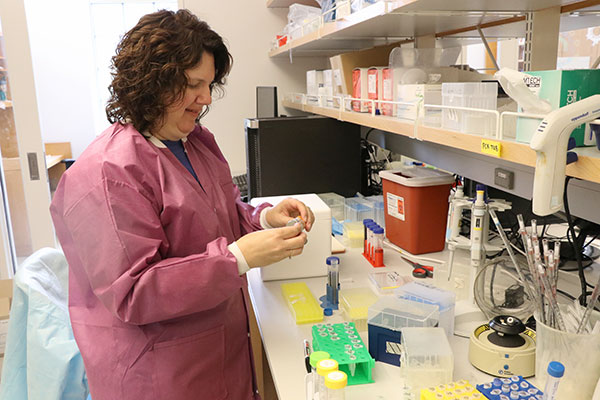Summer school: Vahey lab hosts K-12 educator for curriculum development
Michael Vahey’s lab worked with a local chemistry teacher to develop lesson plans inspired by the team’s work with fluorescence microscopy

When Kirstin Blase learned about a summer position in the lab of Michael Vahey, assistant professor of biomedical engineering at the McKelvey School of Engineering, she was excited by the opportunity to return to research.
Blase, a chemistry teacher at Villa Duchesne, had previously worked in the Division of Radiological Sciences in the Mallinckrodt Institute of Radiology at Washington University School of Medicine, where she researched radioactive compounds used in positron emission tomography (PET) imaging.
“As a scientist, I loved being in the lab and doing research,” Blase said. “As a teacher, the idea of observing real-world research and incorporating it into my classroom sounded like fun.”
The position, funded by Vahey’s recent award from the National Science Foundation’s Faculty Early Career Development (CAREER) Program, allows a local K-12 educator to spend time in the lab developing curriculum inspired by the team’s work with fluorescent microscopy.
“The overarching goal of the program is to have lesson plans developed and published for anyone who wants to try them out in their classroom,” Vahey said. “We want this to be an active partnership with teachers and educators so we can help disseminate that information.”
Vahey worked with the university’s Institute for School Partnership (ISP) to recruit a teacher. The ISP also will distribute the finished lesson plans to the wider community once they’re ready for classroom use.
“One of the hurdles a lot of STEM teachers try to overcome is the idea that this material is too hard,” Blase said. “‘Hard’ just means that it requires more of our attention, focus and energy to master. Every year, I hope that each student has one unit or lab they’re interested in and had fun with.”
Blase spent six weeks in Vahey’s lab working about 20 hours a week. Lab members taught her how to use the fluorescent microscope, as well as to collect and prepare E. coli plasmids, DNA floating within the bacteria’s cell, for later study.
“I interviewed each of the doctoral students to understand what their part of the research was and to build a knowledge base of antibody and virus interactions so I could incorporate that into my chemistry curriculum,” Blase said. “In class, we’ll talk about how vaccines are developed and how an antibody neutralizes a virus. I hope to connect those chemistry concepts to a real-world application.”
Blase has already developed one lesson plan covering antibody interaction with viral proteins and is currently developing another on fluorescence microscopy. One of the biggest hurdles in developing her lessons is making the concepts and tools used in the lab accessible to high-school students.
“Obviously, most high schools don’t have fluorescence microscopes,” Blase said. “When I started with the antibodies, I thought about those structures at a molecular level and what I could get from the craft store that might mimic them and show students concepts such as affinity and avidity. It’s a creative process.”
Vahey said he’s appreciated seeing how his work would translate into a high-school chemistry lesson.
“It’s been fun for me to see how she can take what we’re doing and distill it in a way that’s easy for 10th graders to understand,” he said. “Rather than us trying to decide what we think is relevant, we can go to the people who work with them and already know how they think.”
Vahey also said he plans to bring more teachers and students to campus through the program over the next five years and increase the program’s outreach.
“The National Science Foundation has always had STEM education as a central pillar to its mission,” Vahey said. “We need to expand the pipeline of trainees. By giving students early exposure to science and engineering, hopefully they’ll better understand this is a career option that’s open to everyone.”




